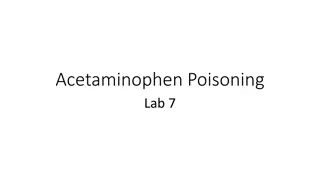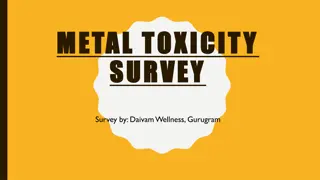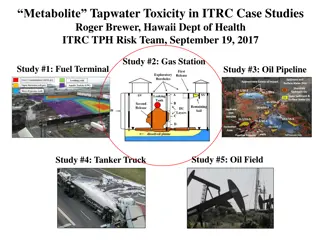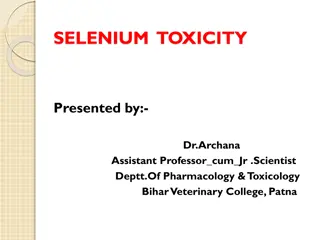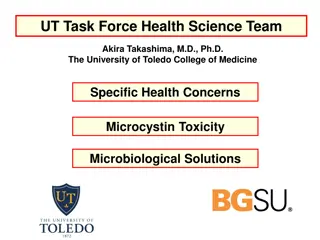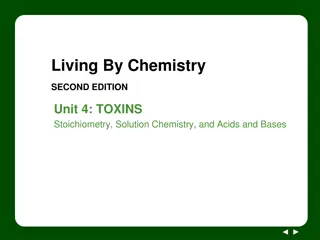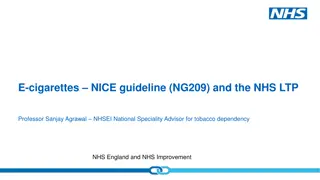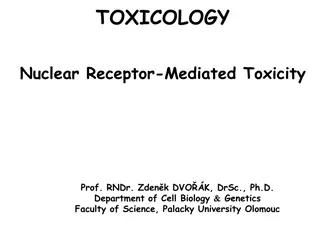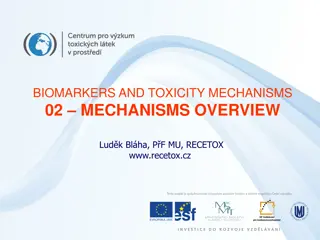Impact of Vaping: Health, Environmental, and Legal Implications
Vaping is considered less harmful than smoking, but it still poses risks to health and the environment. While some adults switch to nicotine vapes to quit smoking, vapes are not entirely harmless and can have short-term effects like coughing. Selling vapes to minors is illegal, as nicotine-containin
5 views • 23 slides
Advancements in Regenerative Medicine for Sickle Cell Anemia
Regenerative medicine holds promise for treating sickle cell anemia through techniques like stem cell transplantation. This approach targets genetic blood diseases, offering potential cures beyond traditional uses like eradicating cancer. Despite obstacles like toxicity and donor availability, innov
8 views • 26 slides
Unmasking the Toxicity of the Film-Forming Finish Paradigm in the Coatings Industry
Exposure to toxic fumes emitted by film-forming finishes during application and drying poses significant health hazards to workers and occupants of coated spaces. Painters, contractors, and DIY enthusiasts are particularly vulnerable to inhaling harmful chemicals, leading to respiratory ailments, he
1 views • 5 slides
Unmasking the Toxicity of the Film-Forming Finish Paradigm in the Coatings Industry
Exposure to toxic fumes emitted by film-forming finishes during application and drying poses significant health hazards to workers and occupants of coated spaces. Painters, contractors, and DIY enthusiasts are particularly vulnerable to inhaling harmful chemicals, leading to respiratory ailments, he
1 views • 5 slides
Understanding Acetaminophen Poisoning: Mechanism, Toxicity, and Treatment
Acetaminophen poisoning occurs when the body is overwhelmed by high doses of the drug, leading to liver toxicity and potentially fatal consequences. The mechanism of toxicity involves the depletion of glutathione and the formation of a harmful metabolite, N-acetyl-para-benzoquinoneimine (NAPQI). Con
2 views • 9 slides
Understanding Aspirin Toxicity: Overview and Management
Aspirin toxicity, though decreasing in incidence, can still result in severe consequences such as metabolic acidosis, seizure, and even death. This condition is often underestimated due to lack of familiarity with its clinical presentation. Treatment focuses on maintaining salicylate in the ionized
0 views • 22 slides
Understanding Toxicology: Dose-Response and Toxicity Assessment
The study of toxicology involves understanding dose-response relationships, lethal concentrations, tolerance limits, toxicity curves, and factors influencing toxicity. Dose, response, acute toxicity, chronic toxicity, LD50, and ED50 are key concepts in toxicology that help assess the effects of chem
2 views • 24 slides
Understanding Local Anesthetic Systemic Toxicity in Anesthesia Practice
Local anesthetics are crucial in anesthesia for their ability to prevent nerve depolarization, but systemic toxicity can lead to serious complications. Last Causes, signs, and max dosage discussion along with the importance of recognizing early signs like lightheadedness, tinnitus, and late symptoms
0 views • 19 slides
Understanding Scorpion Poisoning: Composition, Toxicity, and Mechanism of Action
Scorpion poisoning is a serious issue presented by Meriam Nabil Nasseif, Assistant Lecturer of Clinical Toxicology at Minia University. This comprehensive guide explores the physical properties of scorpions, the composition of their venom, toxicity effects on the human body, and the intricate mechan
0 views • 23 slides
Understanding Nicotine Toxicity: A Comprehensive Overview
Nicotine, a toxic substance found in tobacco plants, has therapeutic uses in treating nicotine dependence. However, exposure to nicotine can lead to toxicity, with symptoms such as Green Tobacco Sickness (GTS). Understanding the absorption, distribution, and metabolism of nicotine is crucial in mana
1 views • 19 slides
Understanding Nicotine Dependence and Treatment
Nicotine dependence is a serious issue, but there are effective pharmacotherapies available to help individuals quit smoking. Nicotine, though not a carcinogen itself, is highly addictive and rapidly delivered to the brain through tobacco products. Treatments like pharmacotherapy significantly impro
0 views • 42 slides
Impact of Nicotine Use in Pregnancy: Risks and Consequences
Smoking and nicotine use during pregnancy pose significant risks, including low birth weight, stillbirth, miscarriage, preterm birth, heart defects, and Sudden Infant Death Syndrome. Nicotine Replacement Therapy is licensed for pregnant women but lacks evidence of effectiveness in smoking cessation
1 views • 23 slides
Analysis of Smoke Density and Toxicity in Various Transport Modes
This document presents an in-depth analysis of smoke density and toxicity in different transport modes, including maritime, railway, and aircraft. It covers classification documents, testing methods, hazard levels, and measured parameters for evaluating smoke density and toxicity levels. The synthes
0 views • 6 slides
Understanding Therapeutic Drug Monitoring and Clinical Pharmacokinetic Parameters
Therapeutic Drug Monitoring (TDM) utilizes pharmacokinetic principles to optimize drug therapy by balancing efficacy and toxicity levels. Historical background reveals a shift from empirical dosing to precise pharmacokinetic analysis, aiming to minimize toxicity risks and maximize therapeutic benefi
0 views • 47 slides
Understanding Metal Toxicity: Risks, Detection, and Impact on Health
Metal toxicity is a growing concern affecting many individuals today, with 41% of Delhi & NCR population testing positive for severe heavy metal toxicity. This survey by Daivam Wellness aims to create awareness about the dangers of metal toxicity and its impact on health, including diseases such as
0 views • 7 slides
Advances in Antimicrobial Drugs: Selective Toxicity and Classification
The development of antimicrobial drugs has significantly improved therapeutics by controlling infections and preventing complications. These drugs target invading microorganisms using selective toxicity, sparing host cells. Antimicrobial drugs are classified based on site, mechanism of action, and c
0 views • 30 slides
Understanding Petroleum Metabolite Toxicity in Environmental Case Studies
Exploring the impact of metabolites from petroleum degradation on tap water toxicity through case studies involving gas stations, fuel terminals, oil pipelines, oil fields, and tanker trucks. The assessment of TPH risk levels in different settings, calculation of screening levels for drinking water,
0 views • 17 slides
Understanding and Treating Tobacco Use Disorder with Dr. David Mendez, MD
Explore the risks associated with tobacco use disorder, learn about nicotine withdrawal, treatment options, and behavioral modifications for tobacco cessation. Discover the impact of tobacco on various health conditions and ways to break free from the addiction through pharmacotherapy, counseling, a
0 views • 12 slides
E-Cigarettes for Smoking Cessation: E3 Trial Summary
A randomized controlled trial led by Dr. Mark J. Eisenberg at McGill University evaluated the efficacy and safety of E-Cigarettes (ECs) for smoking cessation. The study aimed to compare the effectiveness of nicotine and non-nicotine ECs with individual counseling against counseling alone. The trial
2 views • 18 slides
Understanding Nicotine Reduction Strategies for Tobacco Regulation
This information discusses the importance of reducing nicotine content in tobacco products to lower addiction levels and overall harm. It emphasizes the FDA's comprehensive plan for tobacco and nicotine regulation, aiming to shift users to less harmful alternatives. Immediate reduction in nicotine h
0 views • 19 slides
Understanding Selenium Toxicity in Animals: Sources, Mechanism, and Clinical Signs
Selenium toxicity in animals can occur through various sources such as selenium-containing plants. The toxicokinetics involve absorption from the gut and distribution to different body parts. The mechanism of toxicity is linked to the incorporation of selenium in amino acids and proteins, leading to
0 views • 10 slides
Comprehensive Approach to Address Microcystin Toxicity and Solutions by UT Health Science Team
The UT Task Force Health Science Team, led by experts in various fields, focuses on addressing specific health concerns related to Microcystin toxicity. They employ a multidisciplinary approach, utilizing expertise in clinical medicine, public health, microbiology, and molecular biology. The team pr
0 views • 7 slides
Understanding Photosensitization in Plants: Causes and Toxicity
Photosensitization in plants can lead to abnormal skin sensitivity to sunlight, caused by the presence of photodynamic agents in the skin and peripheral circulation. Primary and secondary photosensitization are common, with various plants and toxins contributing to liver damage and biliary occlusion
0 views • 12 slides
Cardiotoxic Glycosides in Plants: Toxicity and Mechanism of Action - Overview
Plants like Nerium oleander, Thevetia peruviana contain cardiotoxic glycosides causing toxicity in animals and humans. Poisoning with these plants can be fatal, affecting the heart and nerves. Toxicity is mainly due to compounds like oleandroside and oleandrin, leading to cardiac failure and gastroi
0 views • 13 slides
Overview of Veterinary Toxicology Syllabus and Topics Covered
Detailed overview of the Veterinary Toxicology syllabus including general toxicology, toxicity caused by metals and non-metals, poisonous plants, agrochemical toxicity, fungal and bacterial toxins, venomous bites and stings, and more. The syllabus covers a wide range of topics related to toxicology
0 views • 12 slides
Important Facts About Nicotine: Usage, Properties, and Sources
Nicotine is a stimulant and parasympathomimetic alkaloid naturally produced in nightshade family plants. It is used in smoking cessation. Nicotine is a hygroscopic liquid, soluble in various substances, and undergoes conversion processes under specific conditions. It has two enantiomeric forms and i
0 views • 15 slides
Understanding Lead Toxicity: Sources, Symptoms, and Treatment in Animals
Lead toxicity, or lead poisoning, can have serious health implications for animals, particularly in cases of ingestion through contaminated sources. This article discusses the sources, toxicokinetic processes, clinical signs, and treatment of lead toxicity in veterinary medicine, highlighting the im
0 views • 14 slides
Efficacy and Toxicity of Carboplatin in the Treatment of Canine Non-Osseous Sarcomas
The study evaluates the efficacy and toxicity of carboplatin in treating macroscopic non-osseous sarcomas in dogs. The research focuses on soft tissue sarcomas (STS) and mesenchymal tumors, exploring carboplatin's limitations, response rates, and toxicity profiles. Aimed at determining the drug's ef
0 views • 15 slides
Understanding Copper Toxicity in Veterinary Science
This presentation by Dr. Archana explores the terminology, sources, toxicokinetics, mechanisms of toxicity, clinical signs, and treatment options related to copper toxicity in animals. It discusses how copper absorption, retention, and elimination are affected by dietary factors, leading to copper a
0 views • 11 slides
Understanding Toxicity Through Stoichiometry and Molar Mass
Delve into the world of toxicity analysis by comparing the amounts of different substances using moles and molar mass. Explore the safety of sweeteners and learn how to utilize these concepts to assess toxicity levels. Engage in thought-provoking discussions and activities to deepen your understandi
0 views • 10 slides
The Dangers of Smoking and Vaping: Effects on Health and Ways to Quit
Vaping and smoking can have severe health consequences beyond just lung and heart issues, including addiction, lung injuries, and even strokes. While quitting smoking may be challenging, exercise can help improve overall health. The prevalence of vaping among teenagers is a growing concern, with man
0 views • 8 slides
Estonian Experience on Regulatory and Tax Policy in Tobacco and Nicotine Products
The Estonian experience on regulatory and tax policy in tobacco and nicotine products highlights the implementation of strategies such as e-liquid tax breaks and excise duty differentiation based on harm caused. The initiative aims to reduce the black market, make legal products more affordable, and
0 views • 12 slides
Guidance on E-cigarettes in Smoking Cessation Programs by NICE and NHS LTP
The NICE guidelines (NG209) and NHS Long Term Plan emphasize the availability of various interventions to help individuals quit smoking, including behavioral support, medication like varenicline and nicotine replacement therapy, and nicotine-containing e-cigarettes. It is advised to provide clear an
0 views • 9 slides
Nuclear Receptor-Mediated Toxicity: Molecular Insights and Implications
TOXICOLOGY research on Nuclear Receptor-Mediated Toxicity by Prof. Zdeněk Dvořák delves into the evidence, molecular properties, structures, and signaling pathways of nuclear receptors such as Aryl Hydrocarbon Receptor (AhR). Detailed information on the impact of AhR-mediated toxicity, including
0 views • 19 slides
Understanding Biomarkers and Toxicity Mechanisms: Overview of Mechanisms in Targeting Biological Macromolecules
This overview delves into different categorizations of mechanisms of action (MoA) based on target molecules, interaction types, and steric specificity. It explores non-specific and specific mechanisms, along with possible categorizations involving membrane toxicity, reactive toxicity, and species-sp
0 views • 8 slides
Understanding Arsenic Toxicity: Mechanisms, Effects, and Treatment
Arsenic toxicity is a significant concern due to its presence in various sources like pesticides and industrial activities. This heavy metal can lead to severe health issues by interfering with normal physiological functions. Chelating agents play a crucial role in managing arsenic poisoning by form
0 views • 13 slides
Introduction to Toxicity and Toxicology in Food Chemical Risk Assessment
This module introduces the concept of chemical toxicity and the discipline of toxicology in relation to food chemical risk assessment. It touches upon historical aspects, such as the case of Socrates' death by hemlock, the contributions of Mathieu Joseph Bonaventure Orfila in forensic toxicology, an
0 views • 18 slides
Inhalation Risk Assessment Through Passive Smoking: Research Findings by IIT-Delhi
A research study conducted by a group of researchers at the Indian Institute of Technology-Delhi focused on assessing the inhalation risks associated with passive smoking. The study involved surveying 142 individuals who were divided into different groups based on age and exposure levels. Risk analy
0 views • 5 slides
Insights into Nicotine Effects and Smoking Cessation Medications
Nicotine acts as an agonist at nicotinic acetylcholine receptors in the brain, impacting dopamine release and opioid activity. It has a short half-life and is metabolized by the liver. Understanding its sedative effects at high doses and the development of tolerance and withdrawal symptoms is crucia
0 views • 29 slides
Advancing In Vivo Toxicity Prediction Beyond Modeling
Explore the challenges and opportunities in predicting in vivo toxicity beyond traditional models. Learn about confidence in toxicity prediction, recently discontinued drugs due to safety concerns, and the importance of recognizing toxicological signals in preclinical stages. Discover how computatio
0 views • 27 slides




